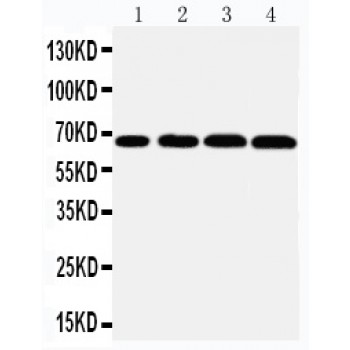More info
Overview
Long Name | Antibody Type | Antibody Isotype | Host | Species Reactivity | Validated Applications | Purification |
| growth factor receptor-bound protein 10 | Polyclonal | IgG | Rabbit | Human, Mouse, Rat | IHC-P, WB | Immunogen affinity purified. |
Immunogen | ||||||
| A synthetic peptide corresponding to a sequence at the N-terminus of human GRB10(550-567aa DGQTFFSLDDGNTKFSD), different from the related rat and mouse sequences by one amino acid. | ||||||
Properties
Form | Lyophilized |
Size | 100 µg/vial |
Contents | Antibody is lyophilized with 5 mg BSA, 0.9 mg NaCl, 0.2 mg Na2HPO4, 0.05 mg Thimerosal and 0.05 mg NaN3. *carrier free antibody available upon request. |
Concentration | Reconstitute with 0.2 mL sterile dH2O (500 µg/ml final concentration). |
Storage | At -20 °C for 12 months, as supplied. Store reconstituted antibody at 2-8 °C for one month. For long-term storage, aliquot and store at -20 °C. Avoid repeated freezing and thawing. |
Additional Information Regarding the Antigen
Gene | GRB10 |
Protein | Growth factor receptor-bound protein 10 |
Uniprot ID | Q13322 |
Function | Adapter protein which modulates coupling of a number of cell surface receptor kinases with specific signaling pathways. Binds to, and suppress signals from, activated receptors tyrosine kinases, including the insulin (INSR) and insulin-like growth factor (IGF1R) receptors. The inhibitory effect can be achieved by 2 mechanisms: interference with the signaling pathway and increased receptor degradation. Delays and reduces AKT1 phosphorylation in response to insulin stimulation. Blocks association between INSR and IRS1 and IRS2 and prevents insulin- stimulated IRS1 and IRS2 tyrosine phosphorylation. Recruits NEDD4 to IGF1R, leading to IGF1R ubiquitination, increased internalization and degradation by both the proteasomal and lysosomal pathways. May play a role in mediating insulin- stimulated ubiquitination of INSR, leading to proteasomal degradation. Negatively regulates Wnt signaling by interacting with LRP6 intracellular portion and interfering with the binding of AXIN1 to LRP6. Positive regulator of the KDR/VEGFR-2 signaling pathway. May inhibit NEDD4-mediated degradation of KDR/VEGFR-2. |
Tissue Specificity | Widely expressed in fetal and adult tissues, including fetal and postnatal liver, lung, kidney, skeletal muscle, heart, spleen, skin and brain. |
Sub-cellular localization | Cytoplasm . Note: When complexed with NEDD4 and IGF1R, follows IGF1R internalization, remaining associated with early endosomes. Uncouples from IGF1R-containing endosomes before the sorting of the receptor to the lysosomal compartment (By similarity). |
Sequence Similarities | Belongs to the GRB7/10/14 family. |
Aliases | grb 10 antibody|GRB IR antibody|grb-10 antibody|GRB10 adapter protein antibody|GRB10 adaptor protein antibody|GRB10 antibody|GRB10_HUMAN antibody|GRBIR antibody|Growth factor receptor bound protein 10 antibody|Growth factor receptor-bound protein 10 antibody|Insulin receptor binding protein antibody|Insulin receptor binding protein GRB IR antibody|Insulin receptor-binding protein Grb-IR antibody|IRBP antibody|KIAA0207 antibody|Maternally expressed gene 1 antibody|MEG1 antibody|RSS antibody |
Application Details
| Application | Concentration* | Species | Validated Using** |
| Western blot | 0.1-0.5μg/ml | Human, Rat Mouse | AssaySolutio's ECL kit |
| Immunohistochemistry(Paraffin-embedded Section) | 0.5-1μg/ml | Human, Rat Mouse | AssaySolutio's IHC/ICC Detection kit |
AssaySolution recommends Rabbit Chemiluminescent WB Detection Kit (AKIT001B) for Western blot, and Rabbit Peroxidase IHC/ICC Detection Kit (AKIT002B) for IHC(P). *Blocking peptide can be purchased at $65. Contact us for more information

Anti-GRB10 antibody, ASA-B0812, Western blotting
Lane 1: Rat Liver Tissue Lysate
Lane 2: Rat Kidney Tissue Lysate
Lane 3: HELA Cell Lysate
Lane 4: MCF-7 Cell Lysate
Lane 1: Rat Liver Tissue Lysate
Lane 2: Rat Kidney Tissue Lysate
Lane 3: HELA Cell Lysate
Lane 4: MCF-7 Cell Lysate

Anti-GRB10 antibody, ASA-B0812, IHC(P)
IHC(P): Human Mammary Cancer Tissue
IHC(P): Human Mammary Cancer Tissue



